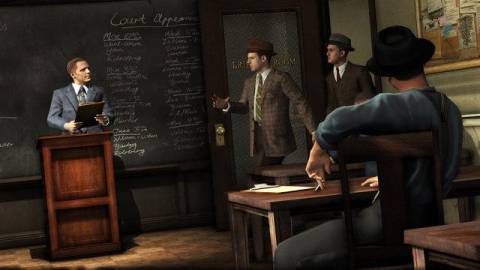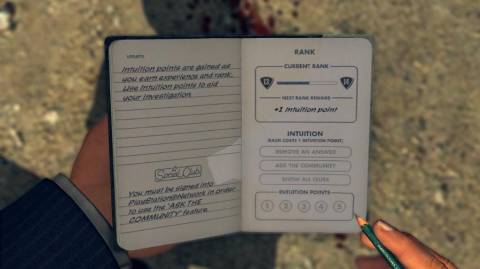It's surreal, the number of long-in-development games that might actually burst forth into the light of commercial release in 2011. In the time since Rockstar Games and Team Bondi's Los Angeles crime saga, L.A. Noire, initially appeared by way of scant few screenshots and little concrete info back in the mid-2000s, children have been born, learned to crawl, walk, talk, and use basic arithmetic. And yet, while some games of similarly protracted and clandestine development cycles perhaps look worse for all that developmental wear, L.A. Noire seems to have benefited from its extended gestation. Though the game was only shown via a developer-driven, 30-minute demo at PAX East 2011, what Rockstar showed certainly made an impression.
At first blush, L.A. Noire seems to have all the hallmarks of a typical Rockstar joint, namely a third-person protagonist wandering around an open world full of sex, murder, corruption, and everything illicit in between. In this case, the setting is 1947 Los Angeles, and you play as Cole Phelps, a young officer in the LAPD rising through the ranks of the department. Phelps, played by Mad Men's Aaron Staton, starts out the game as a beat cop, working the streets and securing crime scenes for the detectives above his pay grade. However, over the course of the game your career will flourish, with stops in a variety of different units, including traffic, arson, vice and homicide.

Instead, we were introduced to intense, brutal violence right from the get-go. A woman is dragged screaming from a car at a popular heavy-petting spot overlooking the city, and is subsequently beaten to death with a tire iron. The faceless killer fades into the dark, and we are introduced to Cole. Upon arriving at the scene with his cantankerous, half-drunk new partner, Rusty Galloway, Phelps goes right to work, bee-lining for the stark-naked and desecrated corpse. Side note: If you are sensitive to seeing fully naked dead ladies, this is probably not the game for you.
After a bit of rat-a-tat back-and-forth with some nosy reporters, Phelps begins investigating. Rockstar emphasized the nature of the game's investigation mechanics, compared with other crime-solving adventure titles. Rather than just poking around until you find the right highlighted object that progresses you to the next section of the story, L.A. Noire is aimed at getting you to use your head and actual investigation. For example, when you examine the woman's body, you can highlight several sections, including her head, her arms, her torso, and so on. While highlighted on those sections, you can use the controller's analog sticks to turn them to look more closely at wounds, markings or other possible evidence. Elsewhere, it pays to be dutiful in your searching. Supposedly, you will never quite know when an object might pertinent to your investigation or not, so it pays to be painstaking when it comes to searching and evidence collection. All of your evidence and information is kept inside your notebook, which keeps a detailed and easily accessible list of everything you've discovered so far.

It's easy to envision a mechanic like this boiling down to a series of painfully obvious visual cues and character tics--after all, subtlety in facial expression is not something games have really done well up to this point. Enter a new form of facial capture technology, which Team Bondi has used to capture the expressions of the actors as they deliver their lines in the recording studio. The aim of this tech is to finally cross over that seemingly insurmountable valley of the uncanny and create video game characters that blink, smirk, furrow, and frown with naturalistic quality. If the demo I saw was any indication, they've nailed it.
Certainly you know you are looking at a game character, but I can't recall a time when I've seen anything this believable and realistic. Lip movements are phenomenal and accurate, with none of the awkward fish-mouthed movements one tends to associate with games. More impressive are the eyes, which don't just dart around based on random algorithms or stare straight ahead at you, like a dead-eyed automaton. Interrogating a suspect, you see the subtle movements, the wrinkles in their brow, the throwaway looks downward that signal something might be amiss. I'm trying to avoid hyperbole because, again, this was just a 30-minute demo. But over the course of that demo, I saw such a wide array of expressions and facial features that frankly, I just couldn't help but be impressed. The one knock is that, by comparison, the body animations seem rather antiquated. Outside of fisticuffs--which, frankly, looked a bit clunky--the basic body movements seemed fine, but when juxtaposed against the hyperrealism of the character faces, the stiffness found below the neck stuck out.
Equally impressive is the game's sense of style and atmosphere. Though it's set a few years earlier, L.A. Noire immediately evokes the look, feel, music, fashion and overall vibe of 1997's Oscar-winning 1950s crime drama, L.A. Confidential. You see it all over the larger world, from the busy, coupe-filled streets to the rundown bungalows and apartment buildings that pock the sprawling landscape. However, it's the smaller details that really dig out the L.A. Confidential thing. One particularly on-the-nose scene features your Irish police captain delivering a matter-of-fact speech on the heinous murder you're about to investigate, while you sit in a wood-paneled room behind clunky desks amid peers of run down men in $30 suits and fedora hats. Much the way that they co-opted the plot, scenery, soundtrack and characters of Scarface for Grand Theft Auto: Vice City, Rockstar seems to have plunged its tendrils deep into L.A. Confidential's cultural elements, and found a way to marry them to the world of their game with a kind of creative reverence.
